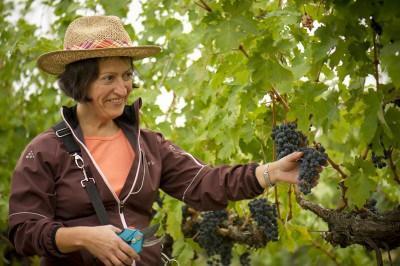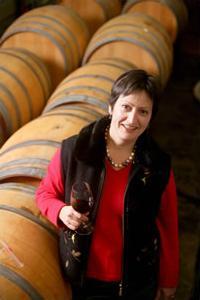
Marie-Eve Gilla, winemaker and co-owner at Forgeron Cellars in Walla Walla, WA.
Old world inspired, new world forged artisan wines, each expressive of Walla Walla’s unique terroirs.

A winemaker’s story is a true hero’s journey – involving obstacles, an occasional mentor, and the ultimate reward - in this case, wine. Details may vary, but never the storyline.
Today’s winemaker, Marie-Eve Gilla of Forgeron Winery in Walla Walla, started her hero’s journey in France, slaying dragons to earn one of five coveted places for women in Burgundy’s prestigious University of Dijon wine school at a time when many male vignerons still believed that women in the cellar caused the wine to turn.
binNotes first tasted Forgeron Chardonnay in 2009 after my first trip to Burgundy, and immediately recognized a grace, elegance and refinement unlike other ‘new world’ chardonnays I’d tried prior.
Today’s Meet the Winemaker series shares her story – the story of a new world winemaker with a deft old world touch and tenacious spirit.
bn: Who or what brought you to the world of wine?
MEG: I was raised near Paris, and born in the Jura – which is close to Burgundy – and all my mother’s family lived there. During the school year we were near Paris but we had this country home and I loved the country. Early on I worked on a farm with goats and geese and it was really fun but if you’re not actually from a farming community and are coming from Paris it’s hard to find a school for farming. So, after I did my equivalencies and started general studies I said, “I am not going to go and get my PhD in something just because.” I wanted to do something that I liked, that’s when I went into viticulture.
When I was studying viticulture in Burgundy I started tasting extraordinary wines, nothing like the stuff my parents had at the table… I became intrigued by these outstanding wines, and decided to pursue winemaking. When you start studying viticulture you’re exposed to the wine and understand a lot more and become sucked into the winemaking. And also, I love chemistry, not so much the chemistry part of winemaking but understanding the chain of events that makes grape juice into wine, a little like the transformation of a caterpillar into a butterfly.
Working on a farm when I was younger was definitely part of my inspiration– I loved to be outdoors. I still get to do that with harvest. I will go usually out to the vineyards in June, July, August, and of course September, so we can see what’s going on and decide when to pick the grapes.
bN: As a Parisian-born, Burgundy-educated winemaker, how did you end up in Walla Walla, WA.?
MEG: I decided to go back to Burgundy to learn viticulture (Bachelor) and winemaking (Master) at the University of Dijon, where I gained practical experience and training in Burgundy’s wineries and vineyards. In 1991, I went to Oregon for a short internship and had the opportunity to stay.
I worked my way up from the bottom, washing tanks and barrels for a while at Argyle. Because the Oregon wine industry was not doing particularly well in the early nineties (a very far cry from the current Pinot Noir success) , I moved to Washington, even if it was a scary proposition to drive from luscious Oregon to dry Eastern Washington in my beat up Ford Escort. I worked with Covey Run, Hogue and Gordon Brothers during the next 10 years. In 2001, I was given the opportunity to become part owner, manager and winemaker at Forgeron Cellars, which was my goal in life (I like to be part of the decision process).
bN: How does your Burgundian training inform the wines you make today?
MEG: There are not very many people interested by white winemaking here. Reds are more masculine, more serious. At least I think that’s how people feel. I have a different vision because working in Burgundy you taste some of the best whites in the world and you just understand about persistence and balance and everything that happens when you taste the wines. But maybe you don’t get that perspective if you’ve been born and raised here.
I had a white wine from Burgundy that I will remember the taste and the longevity on my palate all of my life. It was a Corton-Charlemagne and I understood the power of wine…wine at its greatest. I was an intern at Antonin Rodet in Burgundy and the tasting was part of a quality control session. This wine still inspires me as I aim to always craft the best Chardonnay possible.
I have also had a 1964 Gevrey Chambertin at a family gathering and what impressed me was the ageing that added complexity and the changes it went through as I was savoring it…it was extremely delicate yet incredibly powerful. People think elegance and finesse are weak qualities, but after this experience I understood the importance of elegance and do not perceive it as a weakness. So complexity and elegance are qualities I pursue for my wines.
I make wines that are deep, layered, and rich. These wines are excellent with food and have good aging potential. My wines open up slowly in your mouth like a funnel, complex and focused with good tannins and structure for great balance and a great, lasting aftertaste.
bN: Do you ever go back to Burgundy to visit? If so, what’s it like for women wine
makers in Burgundy today that may differ from when you were there?
MEG: Back in my days (long time ago :), it was extremely difficult to get into winemaking school in Burgundy as they would only take 5 women for every 30-35 students. The reason was that it takes a lot of physical strength to carry barrels up and down steep stairs to the underground cellars. Or maybe the reason was that they just did not want women, some of the cellars actually did not allow women in their barrel caves, said they make the wines turn…
In any case, I had to push really hard to be one of the women admitted to winemaking school because I wasn’t married to a winery owner and I wasn’t already within the wine business. I remember the dean telling me later that he had never seen anybody so persistent; I still wonder if that was a criticism or a compliment?
Things have changed now and it’s about half girls in these schools although it can be quite tough for them to get a job.
bN: Burgundy is known for two primary varietals: Pinot Noir and Chardonnay. What’s it like to work with the broad palette of varietals available in the Columbia Valley?
MEG: Although our core production is Chardonnay, Cabernet Sauvignon, and Rhône blends, Forgeron is also known for experimentation. We started making Zinfandel in our first vintage in 2001. Zinfandel is not a grape that has much of a history in Washington, but we have made one ever since and we have become identified by it. We have also experimented with varietals like Barbera, Sangiovese, and Primitivo. Because Forgeron Cellars’ location is small, we will never get bigger, which allows us to dedicate ourselves to smaller lots of wines and gives us more flexibility for blending and experimenting. That is the main reason (besides ownership) why I joined the winery. I make all the wines with my assistant and having only two people involved allows for very hands on winemaking
But to me, it’s not just about the broad palette of varietals available in Washington; it’s also about the difference in growing conditions between here and Burgundy. I like the vineyards here and I believe that the climatic conditions in Washington are more conducive to making true varietal wines. We only get 6 to 8 inches of rain per year, allowing us to monitor vine vigor with gentle and only necessary irrigation. Our season is shorter so knowledgeable growers know that only low yielding vineyards will ripen in time before the frost. We are still defining ourselves and do not have yet the pressure that Californian wines are facing with competition; we do not have to fit into a mold as we are still shaping that mold.
bN: How does the Columbia Valley’s terroir, including unique features such as native basalt bedrock, glacial till from the Missoula floods, and wind-blown loess, inform your wines?
MEG: I believe that great wines start in the vineyard. You will never produce good wine with bad grapes. Wine ultimately is a function of the soil, grower and climate.
The prevalent dry conditions and sandy loam soils we have in Eastern Washington, combined with the plants being on their own roots, provide conditions extremely well suited to growing vines that will yield intense flavors. I favor very warm sites for my Bordeaux reds, average temperature sites for my Rhone varietals and cooler sites for my whites
After over 15 years in Washington State, I have found some very interesting sites that consistently produce great grapes. I call these terroirs as this is a very important notion for a French person that a particular piece of land will be different from any other and have its own characteristics. It is important to note that a great Cabernet Sauvignon site will often be a terrible chardonnay site so identifying the best site for a given varietal is a huge part of making great wines. Because I do not rely heavily on high fermenting temperature and heavy toast for the aging process, I really need to find great terroir characteristics. I source grapes from different vineyards to produce complexity in the wines.
The interaction of the topography (degree of slope + light & drainage) + soil (sandy loam), weather, and the grower contribute to give a specific personality to the wines made from these grapes. These will give unique characteristics to the grapes that are produced consistently every year.
To me, good terroir is extremely important but also a good relationship with the grower—I need to feel very comfortable and communicate well with the grower.
bN: You’re married to a winemaker (Gilles Nicault, Director of Winemaking and
Viticulture at Longshadows.) That must make for some interesting shop talk. Do
you differ much in philosophy regarding wine making?
MEG: Men are more scientific. I go more from instinct, from my gut — it’s sort of a more romantic approach to winemaking.
While the current fashion is to make very big, dark-colored wines with lots of fruit, flavor, alcohol and oak, women winemakers try for balance and equilibrium in wines, men look for power. My style is more female, more complex and elegant.
We don’t compete because I have found my strengths and he’s found his strengths and we have a very different sense of qualities.
bN: What are your greatest challenges as a wine maker in the Columbia Valley?
MEG: One of the greatest things that happened in Washington is both viticulture and winemaking skills have grown tremendously in the last 25 years. At the same time, the vineyards are getting more mature and the growers are getting savvier at matching specific varietals to specific sites. So we are making better wines all the time, especially with increased competition, that is great for the consumer!
Although the scenery has changed in the last 25 years, the challenges remain. In the early nineties, there was no recognition of Washington wines–my mother thought that I lived in Washington DC for at least 3 years! It was very difficult to get a job in this industry and both my husband and I had a very long commute to our respective wineries (after we got together in Zillah in 1994). Also, there did not seem to be very much expertise in the winemaking side, most people in the business did not travel much and they were not very aware of other wine styles or wine regions. But the industry was very friendly and we all knew and enjoyed each other. It seemed at that time that restaurants and wine shops in Washington State would buy the wine if it was properly made and presented. It was also easier to meet and know all the players and I knew a lot of the accounts in Seattle. At the same time, it was harder to take the wine out of State (especially on the East Coast).
Now the industry has more momentum and it is also more competitive. Growers and winemakers are still working very well together but marketing is much, much more important now, as only the fit wineries will survive. There are also many virtual wineries and winemakers. They do not have a physical place and contract to have their wines made. These “wineries” have business savvy owners who do an excellent job in the marketplace. These wineries do not have the traditional overhead, they buy wines already made and therefore hit the marketplace at a faster pace with well-positioned products.
In a nutshell, there was not much wine awareness and expertise in the early nineties and now wine is a bigger part of life but the industry is also more competitive. Either way, I like both times and am glad that I was able to witness the changes!
bN: Anything else you care to share with readers about Forgeron Cellars that makes it different from other wineries in the area?
MEG: Forgeron is the French word for blacksmith, as the winery/tasting room was the former site of a turn-of-the-century blacksmith shop downtown Walla Walla. The word “forgeron” also has a slightly different meaning in French, referring to artisans who build with their hands combining experience with an extensive knowledge of their trade. We started construction in June 2001, we were winery #23 in Walla Walla at the time, and there are over 150 Walla Walla wineries today.
Walla Walla is more well-known for Syrahs, and those big, bold wines. That’s why also I have done so well, because we are a little bit different – I mean we can make those big wines but we really like to explore a wide variety of styles. My wines have a sense of place. I practice minimal intervention winemaking, enabling each grape to fully express itself. By respecting and listening to the grapes through the fermentation process, I make different wines that truly relate to their origin. Using this winemaking philosophy allows me to craft food-friendly wines of great character. These wines need the magic of barrel and bottle aging to fully develop, they show good balance and integration when young and increased complexity and character as they age.
bN: Finally: “If wine making has taught me anything, it’s taught me…”
MEG: To be patient. To be close to nature. To listen and to let go, because the vintage is going to do what it wants to do. In the end, the winemaker is a shepherd, guiding the grapes through fermentation, maturation and adjusting winemaking to highlight the potential of each lot of grapes.
Indeed. Click here for more information about Marie-Eve Gilla and Forgeron Cellars.
Note: Forgeron Cellars also has a tasting room in Woodinville Wine Country.
Santé!
⚜⚜⚜
Thank you:
Marie-Eve Gilla, Co-Owner/Winemaker – Forgeron Cellars

